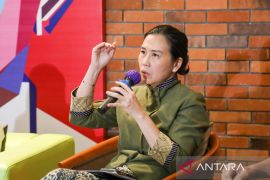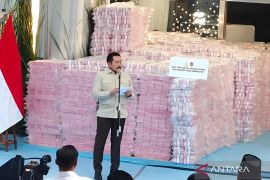As far as the eyes can see, vast tracts of land are now pockmarked with craters filled with highly acidic bluish-green water, glittering deceptively in the tropical sun.
The scale of destruction from unconventional tin mining has reached a level where Bangka island`s original natural beauty - one of its main tourist attractions - will soon be a thing of the past, if nothing is done to stop or control the environmentally damaging tin mining activity.
Therefore, unconventional mining methods and the operations of tin dredging ships in Bangka Island`s tourism sites should soon be restricted.
The Bangka district`s culture and tourism office (Disbudpar) has already asked the relevant local authorities to ban the presence of tin dredging ships and the practice of unconventional tin mining in the island`s tourism areas.
"Tin ore mining activity including the operation of tin dredging ships in a number of important tourism areas in Bangka will eventually destroy the island`s tourism," Disbudpar spokesman Asep Setiawan said in Bangka district town of Sungailiat on Tuesday.
He said tourism and marine fisheries would be the district`s mainstay after the tin ores were exhausted, and therefore all parties should maintain it for the survival of the local community.
It is because tin mining will sooner or later run out and no longer support the local people`s survival.
During his working visit to Babel provincial city of Pangkal Pinang in January 2011, Vice President Boediono was dismayed by the scale of destruction from tin mining and called on the local residents of the province to shift from mining to plantations or fisheries.
"The people of Babel in the long run cannot depend on tin alone because tin mining has its limitations and will end soon," the vice president said at the time.
Boediono made the statement because on his flight from Palembang to Pangkal Pinang he saw much of the forests had been illegally felled for tin exploration and wide expanses of bare land was pockmarked by ponds, filled with turquoise water.
Indonesia has issued new guidelines aimed at curbing illegal mining but authorities in Bangka were keen to see locals shift to other sectors such as trade, fishing and tourism.
But Asep Setiawan said the guidelines and regulation seemed to have gone unnoticed.
"The binding regulation banning the tin mining activities at the distance of 4 miles away from seashore should have been obeyed but in reality it was ignored," Asep said.
He added that the mining activities at present were even conducted 20 meters to 50 meters away from the coast line but nothing was done about it.
Asep said the regulation was beneficial only to the mining sector but extremely detrimental to fishing communities and tourism practitioners.
"Therefore the policy on tin mining exploitation should be reviewed because the reality in the field reveals that it is only beneficial to collectors, brokers, and large investors, while the unconventional miners remain impoverished," Asep said.
According to him, the presence of tin dredging ships and unconventional miners at the coastal areas in Bangka island would affect the natural beauty and marine ecosystems.
"Private pilot for several decades to maintain the tourist sites such as Uber Bay, and the beaches of Parai, Tanjung Pesona, Pasir Padi and the others should not be disturbed by mining activities in order to maintain the tourism assets," Asep said.
He explained that smoke pollution and the roar of the sucking ships machine have become an obstacle for to tourism players in Bangka island.
With the destruction of nature and marine ecosystems perpetrated by unconventional tin miners, Asep said investors in tourism field were feared to leave Bangka for another regions.
Bangka island is actually blessed with marine tourism and historical attractions in abundance.
Having lush tropical forests and surrounded by crystal clear sea with white sandy beaches, Bangka island can be another tourism destination in Indonesia.
After visitors have set foot on the pristine, beautiful beaches such as Parai, Pasir Padi, Sampur, and Matras beaches, returning to their hotels and accommodations will be a hard thing to do.
It is because of these abundant marine tourism and historical attractions that the Pangkalpinang city government is currently making every effort to develop them for both domestic and foreign tourists.
"Besides marine tourism, historical attractions also have a great potential to attract and increase the number of domestic and foreign tourists to visit the island," Pangkalpinang culture and tourism office spokesman Ahmad Elvian has said in Pangkalpinang.
The historical attractions on Bangka island, according to Ahmad, are among others Museum Timah (Tin Museum), Rumah Residen (Resident`s House), Dutch Cemetery, Perigi Pekasem (Pekasem Well), and Tugu Pergerakan Kemerdekaan (monument of independence movement).
"Meseum Timah used to be the house of Bangka Tin Winnig (BTW) workers, and the venue of meetings between Indonesian leaders and the Dutch government before the Roem-Royen conference," he said.
But Ahmad said the house at present had become the tin museum where visitors could learn about the history of tin mining in Indonesia.
Commenting on Rumah Residen, Ahmad said it had a specific historical background as indicated by the presence of two ancient cannons in its compound.
Another historical attraction, according to him, was Pekasem well at Tuatunu village in Gerunggang sub-district, Pangkalpinang.
Ahmad said the bodies of people killed by Tentara Keamanan Rakyat (People`s security force) in the past were thrown into that well.
With appealing natural beauty, the tourism objects in Bangka island should be maintained and kept away from tin mining activities in order to attract a multitude of both domestic and foreign tourists. (*)
Reporter: Otniel Tamindael
Editor: Otniel Tamindael
Copyright © ANTARA 2011











